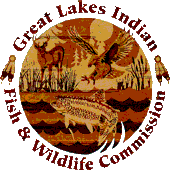RISK MAPS FOR FOREST INVASIVES OF MAJOR CONCERN
IN THE OJIBWE CEDED TERRITORIES
The maps on this page represent our attempt to model potential risk to several trees used by Ojibwe tribal members in the ceded territories, under rights reserved by the treaties of 1836, 1837, 1842 and 1854. These trees include ash, maple, birch, oak, and balsam fir. Several of these trees (ash, oak, balsam fir and hemlock) are facing serious threats from non-native forest pests that are already established in North America. Maple, elm, birch and other native trees are potentially at great risk from the Asian longhorned beetle, if it manages to escape existing or future quarantine areas and becomes permanently established in North America. Because of its importance to moist northern hardwood forests, and the fact that a serious invasive is killing hemlock across eastern North America, eastern hemlock has also been included.
The approach used in constructing these maps is basically a form of GIS overlay analysis, where multiple layers are overlayed with each other in geographic space, in order to highlight and reveal new relationships in the data. As much as possible, factors used in each risk map were chosen based on widely-accepted agreement or (when available) peer-reviewed, published research on their contribution to the spread and impact of forest pests. Our analysis followed an analytic hierarchy process (AHP) for decision-making, developed by Saaty (1977) and adapted for use in GIS by Eastman et al. (1995). Basically this approach assigns weights to factors (in this case, GIS layers) based on their relative importance to the phenomenon being studied. Factors are ranked from most to least important based on "expert opinion", ranging from traditional ecological knowledge to scientific research. A somewhat different version of this approach to risk assessment has been developed by the USDA Forest Service, Forest Health Technology Enterprise Team (FHTET) to predict risks from multiple forest pests to US forests (see Krist et al. 2010 for more information).
For non-native forest pests the FHTET approach breaks the risk assessment process into two parts: susceptibility, which they define as the potential for introduction and establishment in a forest or forested region within 15 years, and vulnerability, defined as the potential for mortality above a certain rate (they chose 25%) over a 15-year period. Forests are therefore only vulnerable if they are susceptible.
The data used in these maps was primarily obtained or derived from a variety of online sources. The tree distribution estimates used in these models are based on MODIS satellite data and US Forest Service Forest Inventory and Analysis (FIA). They were developed by B. T. Wilson and others of the Northern Research Station, USDA Forest Service, St. Paul, Minnesota 55108 (See Wilson et al. 2012 for more information). These maps were constructed as part of Grant #90NR0280 from the US Department of Health and Human Services, Administration for Children and Families, Administration for Native Americans.
THE INVASIVES
>

